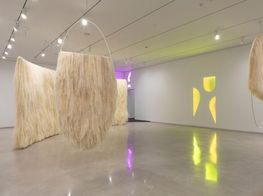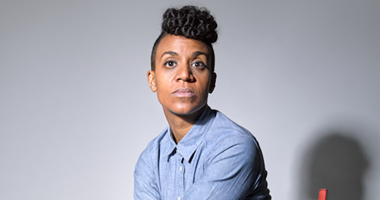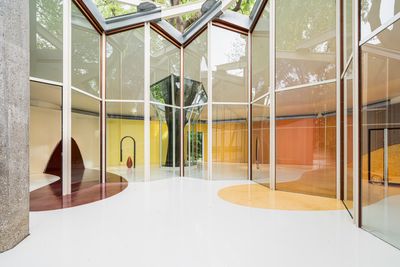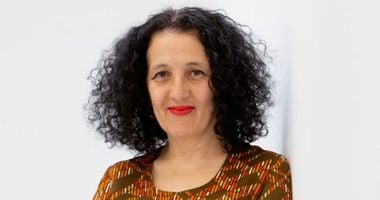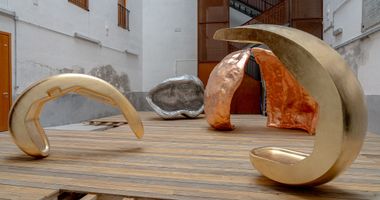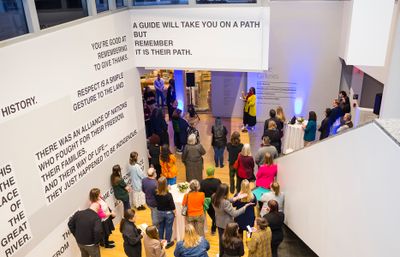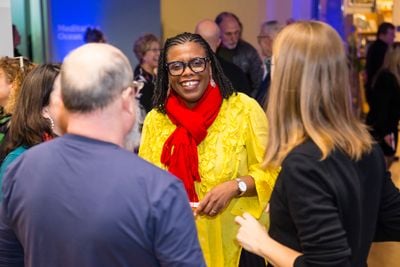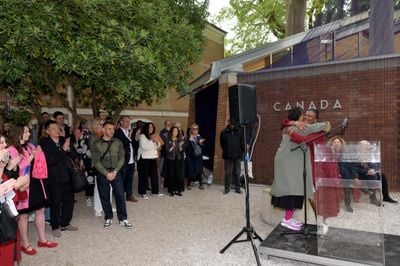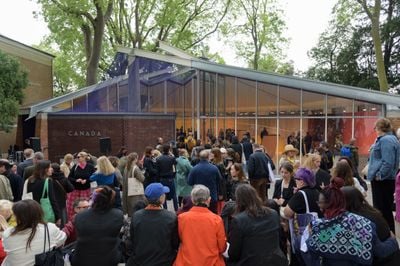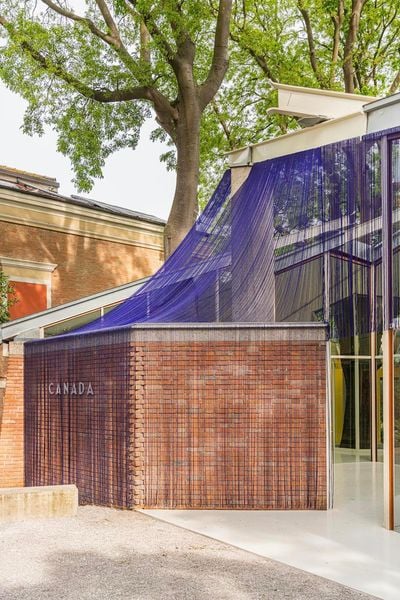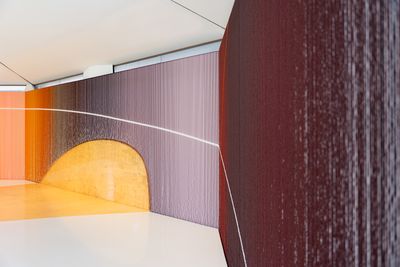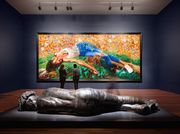Curator Gaëtane Verna on Her Path to Venice and What Follows
Gaëtane Verna. Courtesy Wexner Center for the Arts. Photo: Tyrell Gough.
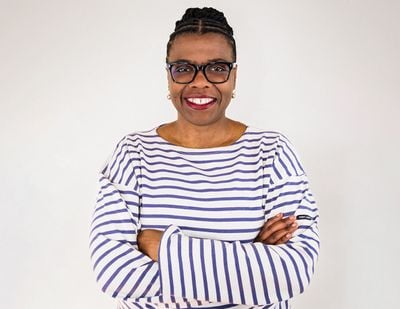
Gaëtane Verna. Courtesy Wexner Center for the Arts. Photo: Tyrell Gough.
In the wake of the Venice Biennale's opening, Gaëtane Verna discusses her journey to curate Kapwani Kiwanga's presentation for the Canada Pavilion, the significance of the materials used in the Biennale show, and what lies beyond it.
The Canada Pavilion at the Venice Biennale, featuring Trinket, an installation by Canadian French artist Kapwani Kiwanga and curated by Gaëtane Verna, has been widely praised. Frieze's critic described it as a 'brilliant meditation', while the New York Times described it as a 'vast and dramatic' work.
Trinket, a stunning installation, showcases intricate displays of glass conterie or seed beads, highlighting their historical significance and impact on global trade and politics, drawing attention to the human cost of extractive capitalism. Deeply embedded in Venice's history, these seemingly innocuous objects were traded for various raw materials, weaving a complex narrative that Kiwanga's exhibition masterfully explores.
Known for her meticulously researched installations, Kiwanga often delves into overlooked histories and themes of gender, colonialism, and social injustice. While she eschews the figurative, her work resonates with intimate human stories through highly abstracted, minimalist, and colour-focused forms. Verna and Kiwanga's collaboration dates to when Kiwanga showcased a major exhibition at The Power Plant in Toronto in 2017 under Verna's direction. Now the executive director at the Wexner Center for the Arts in Columbus, Ohio, Verna was requested explicitly by Kiwanga to curate the Canada Pavilion in Venice.
Beyond Venice, Verna has collaborated with prominent emerging, mid-career, and established artists, including John Akomfrah, Miriam Cahn, Alfredo Jaar, Kimsooja, Young-Hae Chang Heavy Industries, and Zineb Sedira. She has also contributed essays to numerous books and catalogues, further cementing her influence in the art world.
In this edited interview, conducted both before and after the opening of the Venice Biennale, Verna discusses the Venice presentation, her career path, and insights into her curatorial practice.
NPHow did you first get into art?
GVI grew up in a family deeply involved in poetry and art. My parents and extended family were educators and medical professionals who valued the arts and ensured we were exposed to various art forms despite their busy lives raising six children. Art was a fundamental part of our upbringing, from attending film screenings to participating in art conferences. They emphasised the importance of a well-rounded education that included the arts.
NPYou're of Haitian heritage but were born in Kinshasa, Democratic Republic of the Congo (DRC). How did your family end up in Canada?
GVMy parents were exiled from Haiti for political reasons. After being briefly separated, my father went to Jamaica while my mother went to New York. Eventually, they both ended up in Montreal during a significant influx of Haitian intellectuals hired to work there.
My father, a doctor, and my mother, a teacher, lived in Kinshasa for four and a half years, during which I was born in 1965. This was during Mobutu Sese Seko's rule [in DRC, which he would later rename Zaire]. Despite enjoying their time in Africa, my father realised he didn't want to be part of another dictatorship and decided to move. So, they chose Canada, and that is where we were raised.
NPWhen did you decide to pursue art as a career, and how did your childhood in Montreal influence your interest in art?
GVI've always loved the arts but never saw myself as an artist. Instead, I was drawn to supporting artists and facilitating the risks necessary for artwork to be produced. As a child, I dreamt of working in arts administration, initially envisioning myself at the Montreal Symphony Orchestra and, later, perhaps the New York Philharmonic.
Growing up in Montreal exposed me to diverse cultural experiences and fuelled my passion for the arts. While I pursued a BA in management and international business, my focus remained on supporting the arts rather than for-profit ventures.
NPYou also studied in Paris. Tell me about that experience.
GVAfter attending Concordia University in Montreal, I moved to Paris to study arts management, which provided valuable insights into the art market and different art institutions. I also pursued an MA in art history and completed studies at École nationale du patrimoine, where I gained exposure to French curatorial practices. My studies abroad expanded my understanding of the global art landscape and deepened my appreciation for diverse artistic expressions.
NPYou mention valuable insights. Is there anything in particular that impacted how you now think about curating?
GVDuring my education in Paris, I was part of a group called DP Art [Découverte Promotion Art] where we organised studio visits and mini art fairs for artists. That experience taught me the importance of a can-do attitude, resourcefulness, and the power of collaboration.
I was drawn to supporting artists and facilitating the risks necessary for artwork to be produced.
Working with like-minded individuals passionate about their work—even without financial incentives or academic credit—significantly influenced my curatorial approach. It reinforced the value of collective effort and thinking big, guiding me in supporting artists, fostering collaborative projects, and curating exhibitions that create meaningful narratives and educational experiences.
NPWhen did you develop a particular interest in Black artists or Black art in your curatorial practice?
GVMy academic pursuits, including my MA thesis on African American artists in Paris and my research on artists like David Hammons, shaped my focus on Black artists. While my curatorial interests are broad, I've always been intrigued by the intersection of art and identity, particularly within the Black experience. However, I believe in showcasing diverse artists and narratives while recognising the universality of humanistic ideas.
NPIs there an exhibition you worked on before Venice that somehow impacted your approach?
GVNot exactly. I think my career path and cumulative experiences prepared me for the Venice exhibition rather than any single exhibition. However, my work with Kapwani Kiwanga stands out.
I first became aware of her work in 2014 and followed her progress. This long-term engagement culminated in inviting her to exhibit at The Power Plant in 2017, her first institutional solo exhibition in Canada. That project and other collaborations reinforced my belief in the importance of strong relationships, attention to detail, and the ability to activate a global community to support artistic visions.
These experiences emphasised the need for meticulous planning, advocacy for the artist's vision, and the ability to mobilise resources and contacts effectively, all of which were pivotal in my approach to the Canada Pavilion in Venice.
NPHow did being perceived as a Black woman in these spaces and institutions shape your experiences?
GVI've never felt limited by my identity. From organising Black History Month programs at Bishop's University near Montreal to curating exhibitions at various institutions, I've always been supported in my endeavours.
While there may have been challenges, particularly in garnering recognition for my work, I remained committed to my vision and consistently delivered quality exhibitions. I believe in leading by example and creating inclusive spaces celebrating diverse voices and experiences.
NPDid you encounter any challenges in your curatorial development as you took on more senior roles?
GVThere were challenges, such as securing funding and navigating institutional dynamics. However, I was fortunate to have support from colleagues and mentors who believed in my vision. Hard work and dedication were crucial in overcoming obstacles and achieving success. I've always been proactive in advocating for the artists I believe in and creating opportunities for their work to be seen and appreciated. But you have to do the work. There is no way around that.
NPAfter she specifically invited you, you curated Kapwani Kiwanga's artwork for the Canada Pavilion at the Venice Biennale.
GVYes. In Canada, a committee selects the artist to represent the country. In this case, they chose Kapwani, and she agreed to do it. It's important to say that because many artists say no. There is a lot of pressure, and the timelines are always short. The committee allows the artist to choose the curator, and I'm honoured that she chose to work with me.
NPWhat draws you to her work?
GVThe social and political issues she addresses through her art are incredibly powerful. She has a unique ability to delve into complex topics and present them in a visually compelling and thought-provoking manner. Her work often challenges conventional narratives and invites viewers to reconsider their perspectives on various issues.
Also, Kapwani's art is deeply rooted in research and critical inquiry. She combines diverse sources of inspiration, from historical events to contemporary social phenomena, weaving them into her artistic practice with depth and nuance. This multidimensional approach enriches her work and fosters meaningful dialogue and engagement with her audience.
NPCan you discuss the research that led to her settling on beads as a central element of the exhibition? What was the process of conceptualising the installation at the Canada Pavilion?
GVKapwani had been thinking about two potential projects, one of which was centred around trade and beads as money. In March 2023, she and I went to Venice for our first site visit and to see the Canada Pavilion in the Giardini. We were accompanied by the Director of Indigenous Ways and Decolonization at the National Gallery of Canada, who was working on an exhibition titled Radical Stitch.
She recommended we visit Alessandro Moretti from Costantini Glassbeads, with whom she had been in contact for many years. Moretti told us about his family's ties to the production of beads in Murano and showed us some of his vintage bead stocks. Kapwani decided to delve deeper into the history of beads: where they were traded, by whom, and for which materials and resources from the 14th century and beyond. Her proposal for the pavilion is informed by this extensive research in archives in Italy, Europe, North America, and Africa.
NPWas there anything specific about her research that you found particularly interesting and encouraged her to pursue further?
GVThe title of the exhibition, Trinket, was chosen because, through Kapwani's research, we came across several mentions of European traders considering glass beads as mere trinkets that they would trade for resources considered highly valuable under European standards, such as gold, metals, wood, ivory, fur pelts, and humans, among many others.
The entire pavilion is adorned with millions of these glass beads, creating striking tableaus, shaded light, and beaded veils that speak to the history of trade, colonisation, and cultural exchange.
They were under the impression that they were trading something of little value for goods that made them rich in Europe. It was important to acknowledge different regimes of value that appeared in these commercial exchanges and the larger philosophical question of value. This title refers to the key question of value and its role in building the so-called Western world.
NPFascinating. How exactly are these beads used in the exhibition?
GVThe entire pavilion is adorned with millions of these glass beads, creating striking tableaus, shaded light, and beaded veils that speak to the history of trade, colonisation, and cultural exchange. Kapwani invites viewers to contemplate the complex interconnections between cultures and how material objects can carry layers of meaning and value. By engaging with her art, visitors can explore these themes in a thought-provoking and impactful way. Overall, the installation is a space of exploration, discovery, and reflection.
NPWhat projects do you have coming up this year following Venice?
GVWe will be hosting a symposium in June, which is really an extension of the Venice project. It will bring together scholars and experts to discuss various themes related to the exhibition. We want to deepen the understanding and dialogue around the topics explored in Venice. Additionally, I am working on potentially touring the Venice project in Canada to make it accessible to a wider audience who may not have the opportunity to visit Venice.
At the Wexner Center for the Arts, I am overseeing several exhibitions, including showcasing the works of Tanya Lukin Linklater and Jonas N.T. Becker this summer, which were already planned when I joined. In the fall, we will present the works of American photographer Ming Smith. I'm also excited about a significant exhibition featuring Nigerian British photographer Rotimi Fani-Kayode, exploring his impact on the art world and his connections to the U.S. and Yoruba traditions. —[O]

